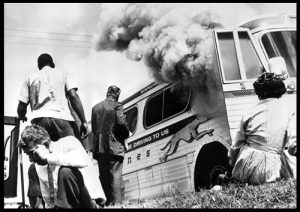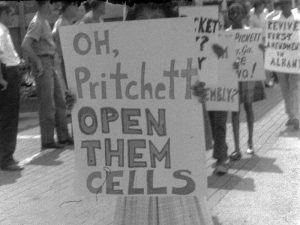Amaya Archie
Many monumental groups were born out of advocating for American Civil Rights. Along with groups still known today like the Southern Christian Leadership Conference (SCLC), the Freedom Riders, and the Black Panther Party, no other group like the Student Non-Violent Coordinating Committee (SNCC) had been as effective and monumental. The Student Non-Violent Coordinating Committee created an unanticipated force, was able to gain mass support, and create impactful campaigns.
In 1960, Ella Baker, “a veteran civil rights organizer and an SCLC official, invited black college students who had participated in the early 1960 sit-ins to an April gathering at Shaw University in Raleigh, North Carolina”.2 During this time, she behooved the numerous gathering of the students in attendance to not affiliate themselves with any other group. After being encouraged by Dr. King who hoped to see the group as a youth wing of SCLC, the group of students made a temporary organization. The force that the group carried can be preeminently seen from the Freedom Rides in 1961. The Congress of Racial Equality (CORE) initially sponsored the rides that began in May to test the 1960 Supreme Court ruling that declared segregation of interstate travel facilities unconstitutional. After riders were heinously attacked with sticks and firebombs, a group of students resolved to finish the rides. This sparked a new reason and determination within the civil rights movement.

The Greensboro Four : Ezell Blair Jr., David Richmond,Franklin McCain, Joseph McNeil

This level of determination, force, and following continued with the sit in movement that became popular in the 1960’s. Four colored students in Greensboro went to a whites only counter and sat patiently to be served. Now this became a movement within itself, which is when MLK encouraged the formation of a group born as SNCC. This group became the key organizers of future sit-ins at lunch counters, swimming pools, and even churches.3 Although they encountered fierce hatred and opposition, slowly but surely more and more lunch counters across the south started to desegregate. This ultimate success of passive resistance but direct action is what pushed CORE to begin the Freedom Rides. The sit-ins were unlike any of its kind because black people were getting beat for simply sitting somewhere, showing white people as the actual aggressors of the issue and as soon as police would come to arrest the students at the lunch counter, another line would come in. This was monumental in itself because the world was able to see people’s children put their lives and futures on the lines for their freedoms, aware of the harms but unafraid.

People protesting against the City of Albany’s decision to jail protesters without a license.
One of SNCC’s most notable campaigns happens to be the Albany Movement which was put in place in 1961 to encourage segregation throughout many mediums which came out of cooperation with many other groups including the youth portion of the NAACP, the Negro Voters League, and many more.1 The movement began with the sole focus being on that of travel facilities by means of sit-ins, mass demonstrations, jail-ins, and boycotts. Later on in the movement MLK and SCLC joined forces, but tensions between them and SNCC soon began to present themselves due to the public stance of Dr. King. Years later, SNCC fell under the leadership of Stokely Carmichael, who was then a new college graduate, who held firmly to Dr. King’s philosophy of nonviolent resistance. Unsatisfied with the pace of the progress, he soon coined the phrase “black power” in which he disbanded white members of the group and called for black autonomy in business, communities, and organizations alike.
One of Carmichael’s most popular public oppositions which showcased his changing philosophy was his criticism of President Kennedy’s call for a Civil Rights bill saying it was “too little and too late.”
https://www.loc.gov/exhibits/civil-rights-act/multimedia/kennedys-civil-rights-address.html
Overall, the Student Non-Violent Coordinating Committee maintained a certain amount of vigor and determination, had a popular platform, and highlighted certain issues of civil rights. Even with an almost spontaneous creation, this student-led group made hedge-way for a good amount of the tough work that needed to be done in the Civil Rights Movement. Although their ultimate demise came from the leadership of Carmichael, SNCC was still able to accomplish necessary tasks to make a mark in history.
CITATION
- `Holliman, Irene V. “Student Nonviolent Coordinating Committee (SNCC).” New Georgia Encyclopedia. July 14, 2006. Accessed April 09, 2019. https://www.georgiaencyclopedia.org/articles/history-archaeology/student-nonviolent-coordinating-committee-sncc.
- `”Student Nonviolent Coordinating Committee (SNCC).” The Martin Luther King, Jr., Research and Education Institute. June 05, 2018. Accessed April 09, 2019. https://kinginstitute.stanford.edu/encyclopedia/student-nonviolent-coordinating-committee-sncc.
- `”The Sit-In Movement.” Ushistory.org. Accessed April 09, 2019. http://www.ushistory.org/us/54d.asp.
